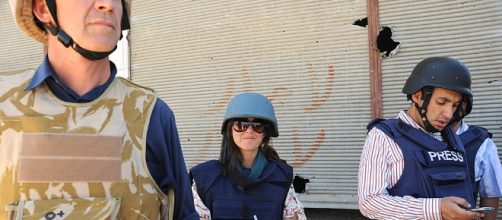Syria is without a doubtthe most dangerousplace on the planet for a journalist. At least 69 journalists have been killed since the civil war began in 2011 and many are still missing after being kidnapped or held hostage by Jihadist militant groups such as the Islamic State.
The question is,does broadcasting accurate and educational information out-weigh the risk factor for those covering on the ground?
Types of journalists
Theterm ‘journalist’ cannot be used broadly in relation to the Syrian civil war. Freelance journalists, citizen journalists and journalists who work for organisations all have to take different approaches to covering a war zone such as Syria.
During the Arab Spring, young media activists across the Middle East revolutionised against the Arab Socialist Baath Party and thus the presence of citizen journalists came about. Many citizen journalists are brave enough to report on ground and send their videos, articles and photographs to the international media - who are extremely reliant on local reporters.
It seems the emergence of citizen journalistsgave the international press a metaphorical key to enter the country and work alongside Syrian media outlets and fixers to report on the conflict. Working cooperatively with natives not only heightenssafety, but alsoadvancesknowledge on the intricacies of one of the worlds most complex wars.
Meanwhile, many other Western news outlets refused to let their journalist’s report in the country, after killings and kidnapping began, and so we saw the emergence of freelancers in Syria, a more independent type of Journalism.
Freelancers vs reporters
The demand for freelancers is vastly increasing; they work for themselves and usually integrate themselves into the lifestyle and culture of the country they are reporting from. They have no company to fall back on; no training, no security, and little resources such as protective clothing. Death isn’t the only risk freelance journalists face in covering war zones; many in Syria have be known to be kidnapped and taken hostage, as a way of beingsilenced.
John Cantlie, a British freelance journalist, was captured in November 2012 by the Islamic State. Since his capturing, a total of six videos have been released by the group in which he has appeared. Cantlie is amongst many journalists whose fatelay in the hands of ISIS.
However, one of the biggest problems journalists face in Syria is location. The country has forgone the traditional stereotype of war where two opposition armies are fighting at the front line. The complexities of the conflict are reflected geographically on ground in Syria. Journalists are at risk entering both an active military war zone and a quiet civilian village.
In the past, throughout the civil war, journalists have been known to be captured by a combination of government forces, rebel groups and terror groups – despite being assured that government controlled areas are safe to report from
Risk of bias reporting
Reporting from a certain region within Syria runs the risk of bias reporting.
If Government controlled areas are one of the few which are supposedly safe to report from, surely the reason behind this is because Assad wants positive Western reportage.
A journalist’s primary aim should be to successfully and accurately report the truth. If they are conforming to the Assad’s regime and purposely missing out information, is there any point in reporting on ground?
We should be grateful for the press
In conclusion, we have to lot to thank Syrian journalists and foreign correspondents for. One could argue the world relies on journalism in Syria. Many foreign correspondents risk their lives to report on the conflict to reach an international audience and spread awareness.
If journalists, including citizen journalists, didn’t have this innate passion to report on the corruption, brutality and humanitarian perspective of the conflict, would we all be totally ignorant of the situation in Syria?

